One of the great things about writing for StogieGuys.com is that I get to meet some interesting people involved in the industry. Frank Herrera is no exception. Frank is an intellectual property lawyer in Florida, publisher of CigarLaw.com, and the owner of La Caridad del Cobre (LCDC). He recently spoke with me about starting his company, the next step for LCDC, the state of the trademark law in the industry, and more:
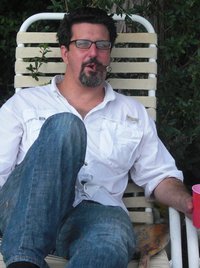 Stogie Guys: How does a lawyer end up in the cigar industry?
Stogie Guys: How does a lawyer end up in the cigar industry?
Frank Herrera: Back in 2001, when I was a new lawyer, I began to help some small cigar makers with the trademark applications. One cigar maker who has been in the business since 1995 or so came to me with a trademark dispute. At the time I was working for a law firm that did not allow me to alter my billing, or otherwise provide pro bono work for business clients. I basically gave him lots of advice on how to defend himself. I told him what books to read, where to get them, and basically gave him a litigation plan on how to fight the trademark dispute. Years later I ran into him at IPCPR (then RTDA) and he thanked me. He told me that he followed my advice to the letter and defended himself and won his case. He told me that winning saved his company and gave him the strength to continue in the business. His new cigar’s name is reflective of his company’s resurrection.
In 2002, I took on the Guantanamera case. Since then, we’ve been defending the trademark against Corporacion Habanos, S.A. at the Trademark Office and now on appeal at the U.S. District Court for the District of Columbia. Apart from the Cohiba case (which General just won) this is the longest running cigar trademark dispute between a U.S. company and Cuba. Thus, in representing these clients since 2001, I’ve learned a great deal about all aspects of the industry. Over the years I learned to appreciate the uniqueness of the industry. I particularly like the fact that it combines all the things that I enjoy: cigars, trademarks, history, culture, agriculture, and of course the social aspect.
SG: What has been the biggest challenge in launching La Caridad del Cobre?
FH: The biggest challenge getting LCDC off the ground is actually convincing myself to commit to the project. I started the brand in early 2009, but I made some bush-league mistakes. The biggest early mistake was that I approached it as a hobby. At that time, I was intimately familiar with the business (having counseled clients on nearly every aspect of it), but yet I was only spending a few hours a week on the brand. At IPCPR last year I shared a booth with a friend just so I could dip my toe in the business at the national level. That was a considerable waste of time and resources since I was completely unprepared. The minute I got back from IPCPR I committed myself to making a great product and to work on the brand. I’m excited about this year’s IPCPR, and I think that you will agree that I got my shit together. Another big mistake was refusing help from some very notable persons in the industry.
Over the past year, that has changed. I’ve been extremely lucky to be associated with some great minds in the cigar business. Most have helped me in recognition of my long hard (and until recently solo) fight against Cuba’s trademark wars. In a strange way, defending these cases against Cuba is my way of political protest. I like to think about it in the context of a U2 lyric about Helter Skelter… “This is a song Charles Manson stole from the Beatles…we’re stealing it back.” Thus, Fidel Castro stole Guantanamera and a multitude of other trademarks, dreams, lives, etc… “I’m stealing it back.” It’s not enough that Cuba has been socialist/communist for all these years disrupting lives and families. Now they are filing countless trademark oppositions and cancellations against small, under-funded cigar companies for their use of terms or phrases that are their only way of preserving their pre-Castro culture. Fuck them.
SG: What is the next step for your company after the trade show?
FH: The next step for LCDC? Fulfill the IPCPR orders and tour the country visiting shops. Continue to create cigars that I can stand behind and be proud of. I’ve got lots of ideas for new brands, new vitolas, and new blends, so I’m excited about dedicating myself to this. I wanted to come out with a cigar this year called “La Fiera,” which means fierce woman (I’ve encountered a few over the years), but I just couldn’t find the right blend to bring that cigar to life. I’m certain that I can breathe some life into her by next year. I’m also working on a Tres Triste Tigres culebra. The name means the “three trapped tigers. ” It’s the title of a famous book written by the Cuban author Guillermo Cabrera Infante. It’s going to be two naturals inter-twined with a maduro. In the myth/religious story of La Caridad del Cobre, three men were in a rowboat and were facing death on the high seas. It was two white Cubans and one mulato. Thus, the idea is blend the LCDC myth/religious story with Guillermo Cabrera Infante’s Tres Triste Tigres.
SG: What is your opinion on the state of trademark law in the industry?
FH: This industry is all about trademarks. Let’s face it: Without a trademark, only the true aficionado would be able to differentiate most cigars. Trademark law is hot across the board regardless of industry, and the cigar industry is no different. However, unlike other industries, a great deal of cigar disputes are actually between Corporacion Habanos, S.A./Cubatabaco and small to mid-size family-owned cigar companies. Over the past ten years Cuba has committed itself to clearing the record of the U.S. Patent and Trademark Office (“USPTO”) of any trademark that looks, smells, or tastes like it might suggest a connection with Cuba.
It might surprise you, but I think that cigar trademark disputes should be resolved without any litigation or lawyers. The cigar industry is like no other industry. To use a sexist phrase, it’s much more gentlemanly. Gentlemen should resolve disputes without lawyers and the courts.
SG: Do you remember your first cigar?
FH: My first cigar? Must have been an unbanded candela that I stole from my uncle Arturo Herrera when he was visiting my family farm in central Florida. I was like 14 or 15. Loved that guy. He would visit with my aunt Lola and I just remember the smell of the cigar and their happy faces. They’ve both passed on, but I still remember him with a cigar and those good times. Not sure that you could pay me now to smoke a candela but, who knows, maybe I’ll come out with one in the future. Of course, I can’t call it Arturo for trademark purposes (laughter). Maybe Lola?
SG: Besides your own stuff, what other cigars have you been enjoying lately?
FH: I dig anything that Dion Giolito makes. Gran Habano. Canimao. La Tradición Cubana.
Many thanks to Frank Herrera for speaking with us. For more information, visit CigarLaw.com and La Caridad del Cobre.
–Patrick M
photo credit: Facebook
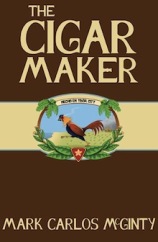 “I’d take a cigar and go outside and…ponder where the story was going to go. Maybe bring a notepad with me and just jot down some ideas,” said McGinty, 35. “Yeah, it did get me through a lot of, I guess, moments of writers block, if you want to call it that.”
“I’d take a cigar and go outside and…ponder where the story was going to go. Maybe bring a notepad with me and just jot down some ideas,” said McGinty, 35. “Yeah, it did get me through a lot of, I guess, moments of writers block, if you want to call it that.”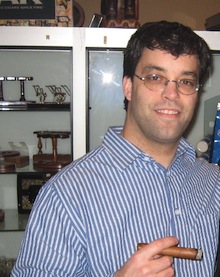 The book has another family connection, too. McGinty’s wife did the striking cover illustration, a cigar-smoking rooster wearing a derby and striding across a tobacco plantation. The rooster made such an impression that it’s now available on mugs, T-shirts, and other items.
The book has another family connection, too. McGinty’s wife did the striking cover illustration, a cigar-smoking rooster wearing a derby and striding across a tobacco plantation. The rooster made such an impression that it’s now available on mugs, T-shirts, and other items.
 Stogie Guys: How does a lawyer end up in the cigar industry?
Stogie Guys: How does a lawyer end up in the cigar industry?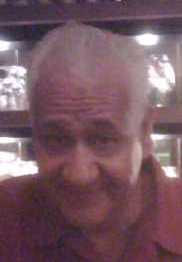 Tin Tin’s is currently the only cigar bar in The Netherlands, a feat made possible by Ze’s efforts to maintain opposition to the laws within the court system, as well as by being the sole employee of the bar. Recent developments, however, have changed the status quo for Dutch smokers and made life more difficult for those who wish to preserve the tradition.
Tin Tin’s is currently the only cigar bar in The Netherlands, a feat made possible by Ze’s efforts to maintain opposition to the laws within the court system, as well as by being the sole employee of the bar. Recent developments, however, have changed the status quo for Dutch smokers and made life more difficult for those who wish to preserve the tradition.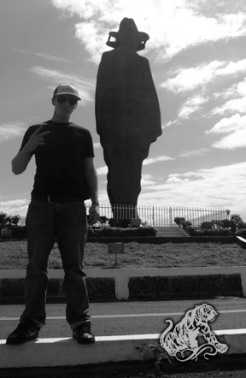 Chris—pictured in front of a national monument for Augusto Sandino in Managua, Nicaragua—recently spoke with StogieGuys.com about mastering the trade, the challenges of working in another culture, and what sets Tesa apart from the competition.
Chris—pictured in front of a national monument for Augusto Sandino in Managua, Nicaragua—recently spoke with StogieGuys.com about mastering the trade, the challenges of working in another culture, and what sets Tesa apart from the competition.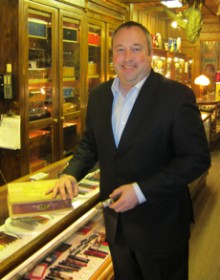 Second Growth comes in only one size: an immense (7.9 x 54) smoke that takes a full two hours to enjoy. Produced by Henke Kehlner of Davidoff, the cigar is mild- to medium-bodied, extraordinarily creamy, and balanced, with subtle notes of cedar and spice. The single sample I smoked had plenty of subtleties and twists to keep an attentive smoker enthralled.
Second Growth comes in only one size: an immense (7.9 x 54) smoke that takes a full two hours to enjoy. Produced by Henke Kehlner of Davidoff, the cigar is mild- to medium-bodied, extraordinarily creamy, and balanced, with subtle notes of cedar and spice. The single sample I smoked had plenty of subtleties and twists to keep an attentive smoker enthralled.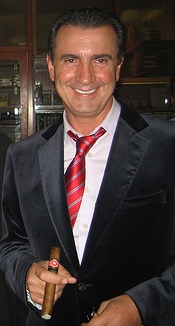 Air Bender, formerly a blend exclusive to La Flor Dominicana events, sports an Ecuadorian Habano wrapper and Dominican binder and filler tobaccos from Litto’s farm in La Canela. He’s been stockpiling the wrapper for a few years now to make sure that he can keep the blend consistent going forward. Not as spicy as his well-regarded Double Ligero blend, the intended profile is of “refined power,†says Gomez.
Air Bender, formerly a blend exclusive to La Flor Dominicana events, sports an Ecuadorian Habano wrapper and Dominican binder and filler tobaccos from Litto’s farm in La Canela. He’s been stockpiling the wrapper for a few years now to make sure that he can keep the blend consistent going forward. Not as spicy as his well-regarded Double Ligero blend, the intended profile is of “refined power,†says Gomez. Patrick Ashby
Co-Founder & Editor in Chief
Patrick Ashby
Co-Founder & Editor in Chief Patrick Semmens
Co-Founder & Publisher
Patrick Semmens
Co-Founder & Publisher George Edmonson
Tampa Bureau Chief
George Edmonson
Tampa Bureau Chief